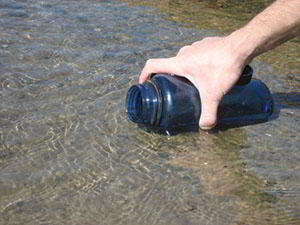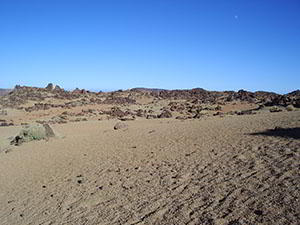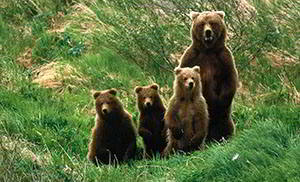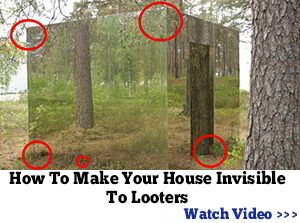Survival show hosts make surviving in the wilderness look like a walk in the park. Don’t be fooled into thinking that the bush contains a veritable buffet of food.
Unfortunately, the mainstream perception of wilderness survival is fraught with misinformation and half-truths like these 5 myths that will get preppers killed.
Myth 1: Living off the land is easy: basic necessities are everywhere
Survival shows have especially made this myth take off. The concept that whatever danger you find yourself in, there is a fairly straightforward way out (as long as you have the right knowledge) is a hot seller right now. However, living off the land in the wild is not as easy as it seems on T.V.
Shelter may be needed immediately, and if you don’t know how to find the right materials and get yourself set up in short order, you could be done for. Here is a simple way to find shelter in the wild without actually building it.
Myth 2: Food and water are everywhere, you just need to know how to find them
Related to the first myth, the idea that it is easy to find food and water in the wilderness is perpetuated by the ease in which television survival experts seem to find their meals. You may notice, however, that none of these experts are in the wilderness for significant periods of time in these shows. Although it is true that in many climates there are a lot of edible plants around, it is also true that most of them are very low in calories, and are not available for much of the year.
On top of that, unless you are an expert in plant identification, there is a chance you will poison yourself with a look-alike. Likewise, it is unlikely that you will promptly find wild game and be able to hunt it and process it without the right skills and tools.
Unless you are lucky enough to find a large amount of nuts and abundant high sugar fruit, you will have difficulty getting enough calories from the wild. Yes, you can get your vitamin C from pine needles, and many wild foods are packed with nutrition, but it’s the calories you need to keep yourself going for more than a couple of weeks.
 Water can be equally challenging to find, especially clean water. You may find a stream, but it is impossible to know without laboratory equipment whether the stream is contaminated with biological or chemical threats. You may have a good drink and then end up losing all that hydration and more through diarrhea and vomiting if the water source is contaminated (not to say that at times it may not be worth the risk).
Water can be equally challenging to find, especially clean water. You may find a stream, but it is impossible to know without laboratory equipment whether the stream is contaminated with biological or chemical threats. You may have a good drink and then end up losing all that hydration and more through diarrhea and vomiting if the water source is contaminated (not to say that at times it may not be worth the risk).
Better to go into the wild prepared with survival rations and a good water filter, as well as extensive knowledge of wild foods high in calories, including where to find them in a given ecosystem, and when they are available. Cattail roots, for example, are among the most nutritious high calorie foods common in many ecosystems. Cattail is also known as the supermarket of the swamp because of it’s many survival uses. Certain nuts are also good, if you know how to process and store them (hint: roasted, cool, dark, and dry).
Myth 3: You must find food immediately when lost in the wild
 You may have noticed in fictional shows and movies that people often get desperate for food just after they go into the woods. However, you can survive up to 6 weeks without food, so this should not be your top priority when you are lost in the wilderness. Instead you should be looking for shelter and water, and the order of importance depends on the situation you are in.
You may have noticed in fictional shows and movies that people often get desperate for food just after they go into the woods. However, you can survive up to 6 weeks without food, so this should not be your top priority when you are lost in the wilderness. Instead you should be looking for shelter and water, and the order of importance depends on the situation you are in.
Quite often, shelter may be first. If you are in a blizzard in the mountains, for example, or even in a mildly cool night area, the energy you lose trying to stay warm and comfortable can easily do you in, so shelter, and possibly fire, are your first priorities.
If you are in an exceedingly sunny and hot climate with no shade, shelter will be equally important to maintain hydration and health (and do your best to fashion a hat and other cover if you don’t have any). If you are in a stable climate with optimal temperatures (including at night), no rain, and plenty of shaded space, water may be your first priority. Only when these two necessities are taken care of should you turn your attention to food.
Myth 4: Starting a fire is as easy as rubbing sticks or banging rocks together
Starting friction fires or fires from sparks created by banging rocks together is not easy and requires a lot of practice to get the hang of, and even then is not possible without the right conditions and materials. Starting a fire with any technique can be difficult in damp or windy conditions even for a seasoned expert with the right materials.
If you’re lucky enough to be in an area with flint or quartz, you may be able to create sparks to light your tinder with the right rock banging technique, but again, it will take a lot of practice, and ideally direction from an expert at first. Likewise, friction fires also require patience and skill.
Myth 5: Play dead during a bear attack
 Do not be fooled by what you have seen on television or have heard in stories. Playing dead when faced with an aggressive bear can actually get you killed. You probably know that running or climbing a tree is also futile, but bears are not stupid and they will usually try to kill you until you are really dead. If you see a bear trail, steer clear, and bring bear spray with you when you are in bear habitat, making plenty of noise to keep the bears at bay.
Do not be fooled by what you have seen on television or have heard in stories. Playing dead when faced with an aggressive bear can actually get you killed. You probably know that running or climbing a tree is also futile, but bears are not stupid and they will usually try to kill you until you are really dead. If you see a bear trail, steer clear, and bring bear spray with you when you are in bear habitat, making plenty of noise to keep the bears at bay.
If you do see a bear or other predator such as a mountain lion, do not play dead as a first line of defense. Instead, try to make yourself look bigger by opening up your jacket and extending it to your sides, stand tall and make lots of noise. Only if you are already being mauled and there is no hope of fighting back (ideally with a hard or sharp object to the eyes and nose) should you consider playing dead in hopes that the bear will no longer see you as a threat. Even then, your only hope is that the bear isn’t hungry and was simply trying to neutralize a threat.
You may also like:
 3 Quick Shelters (The Last One is Invisible!)
3 Quick Shelters (The Last One is Invisible!)
The Medical Guide You Can Use In The Wilderness (Video)
How to Make Candles out of Pine Resin (With Pictures)















Always excited to learn something new. Always ready to refresh my memory on what to do in any scenario. I love it every time i see something new.
Bear rule: If it is black, fight back; if it is brown, lie down. Grizzlies are extremely unlikely to be intimidated, although black bears are possible. Michael Dunn survived a griz attack with “play dead” and he learned that from the highest possible authority.
https://www.mormonchannel.org/listen/series/why-i-believe-audio/michael-dunn-episode-17
Very good advice about hiking in bear country. I was told to sew little bells to my jacket so as to make noise as I walked to avoid surprising a mamma bear and her cubs. Also to carry bear spray. You should also make sure to be able to tell the difference between black bear poop and grizzly bear poop as black bears are not as aggressive as the grizzly. Black bear poop will have grass, berries, grubs and nuts in it and smell horrible. Grizzly bear poop will have little tiny bells in it and smell like pepper spray.
i saw this printed on a sign on a trail in Alaska. I about pissed myself laughing. I also carried my .45.
I carried a .357 and an Alaska local thought I was an idiot. He carried an 18″ 12 gauge double. One side was 00 and one side was a deer slug. I was humbled. He said I should file down the front sight so it wouldn’t hurt as much when the brown bear shoved it up my [behind]
Excellent!
I spent May through Aug on Kodak island right on the edge of the bear refuge…a couple of “guides” that arrived later carry .375’s…me? I carry a Rem 870 12 ga. With 00 buck and slugs no time for thinking or trying to be humane when defending life against a bear. Better be paying attention and remember you’re in their neighborhood! Be respectful, if you want trouble they’ll ablige you!
When I was in Alaska I carried a 44 Mag. I asked Ruger for recommendations on hot loads for my Blackhawk. We loaded to their specifications behind 246 gr. hollow points. I never shot a bear, but I killed 2 Caribou with it. One I shot in the neck. It took out about 6″of the neck bones. The other I shot in the head and about destroyed the head. I felt naked without that gun on my hip.
That is some great advice my friend, I love this education and experience from the best, this advice is what really will save your life,, Thank You
As usual, a great quick read full of useful facts. Thanks again Claude!
#1 & 2. The wilderness IS a bounty of food and water and shelter, etc., BUT you have to train for it and live it. There aren’t many of us who are willing to make the commitment, nor sacrifice that transposes into success. This isn’t a skill you turn on & off, it is more so a way of life.
#3. Very good point made here. Initial assessment is huge and needs to be accomplished quickly – Time is critical often times. Food is more easily held off than Shelter, Water, Clothing and Security, but it doesn’t diminish its importance. The more fat on the human body, usually translates into more reserves and the body will feed off those reserves when needed, thus buying you some time. Now this doesn’t mean that fat people can survive longer, because there are a WHOLE lot more factors that go into that equation. What I am saying is that very skinny people have very low reserves in this area and need more of a steady uninterrupted food supply. There will be exceptions to my point here, but for 90-95% it holds true and the best prepared will have modest fat reserves. I think you get the picture – I hope. Of the 4 times I’ve had to treat people in the wilderness for entering hypothermia, it has always been those who are lean and even with muscular lean bodies.
#4. Anyone who finds themselves in the position of being in the wilderness without at least 2 sources for producing fire is insane. Other than a plane crash or escaping from thugs what would you be doing in or close to the wilderness without fire producing systems????? This one doesn’t register with me and anyone culpable of such a scenario is probably best left to their own demise – seriously!
#5. Bear and Mountain Lions and the possibility of attack relates directly to 360% security and that’s spherical, especially for the cats. dpc j says it best above. I have never been in Griz land and have no firsthand experience – just studied. Lions have made visits to my parts and have inflicted damage/death to livestock and 2 reports of injuring humans. Just imagine your always hunting house cat about 20 times its size and 30-40 times its weight hunting YOU! They’re stealthy and lethal and hunt from positions overhead. Just lucky their numbers are very few. 95% of black bears will avoid you at all costs, it’s the 5% you hear about that troubles the mind. I’ve live in, camped, canoed, hiked black bear country for over 40 years and have yet to have one even give me the sign they may attack. Maybe I’m just lucky, but I’m always prepared. I would recommend ANYONE spending time in the woods to study the materials and history on these threats. Learn identification of active areas, avoidance, the warning signs and defenses. I’ve never had to go beyond the avoidance step, but extremely knowledgeable on the last two.
Hope this helps.
Well done. Regarding natural shelter, I have camped under overhangs, abandoned mine entrances, and used lava tube caves to get out of severe weather. Anything you can do to minimize your exposure to dangerous temperatures and wind is important.
Caves and abandoned mines are indeed the frequent habitat of animals. I once had to quickly evacuate a mine adit that was occupied by a hibernating black bear. My point is, if you are forced into a situation where you need to find natural shelter, don’t abandon due caution.
Does a bear shit in the woods ? YOU sure WILL if you encounter one that’s big and aggressive or hungry and ready to eat you !!! As the old saying goes ; “Some days you eat the bear and some days the bear eats YOU” , don’t let THAT day EVER come !!!
I had a very good friend who was stationed at a remote Air Force DEW radar base in Alaska some years ago. When any of them went fishing in nearby streams (loaded with trout) they were required to carry a 12 gage shotgun with slugs. If that doesn’t sharpen your focus on the potential threat, I can’t think of anything that would.
I carried a .357 but an old Alaska hand told me a shotgun with 18″ barrel was much better.
The best information. Thank you
Alas, “THAT BOOK OF FACES has FOR THE 4TH time “BLOCKED me for sharing a COMICAL photo of some guy wearing shorts with a small wet spot on his shorts, “TELLING ME” it VIOLATES “THEIR TERMS”??? I SHALL STRIVE TO NOT “EVER” use that “BOOK OF FACES”. After-all… THEY ARE a SOCIALIST_MARXIST_COMMUNIST SITE. Welcome to the UNITED STATES.. formerly the united states of America!
Alas, “THAT BOOK OF FACES has FOR THE 4TH time “BLOCKED me for sharing a COMICAL photo of some guy wearing shorts with a small wet spot on his shorts, “TELLING ME” it VIOLATES “THEIR Every time I attempt to share this, I’m told it a DUPLICATE”.. WHAT? TERMS”??? I SHALL STRIVE TO NOT “EVER” use that “BOOK OF FACES”. After-all… THEY ARE a SOCIALIST_MARXIST_COMMUNIST SITE. Welcome to the UNITED STATES.. formerly the united states of America!
This is a good article because it makes you stop and think. Makes you realize things aren’t as easy as one might think, and while you may plan for the details, the obvious things could get you. Like watching for bear but forgetting about badgers, wolverines, snakes, or any small rabid animal. Or just plain exhaustion or freezing….